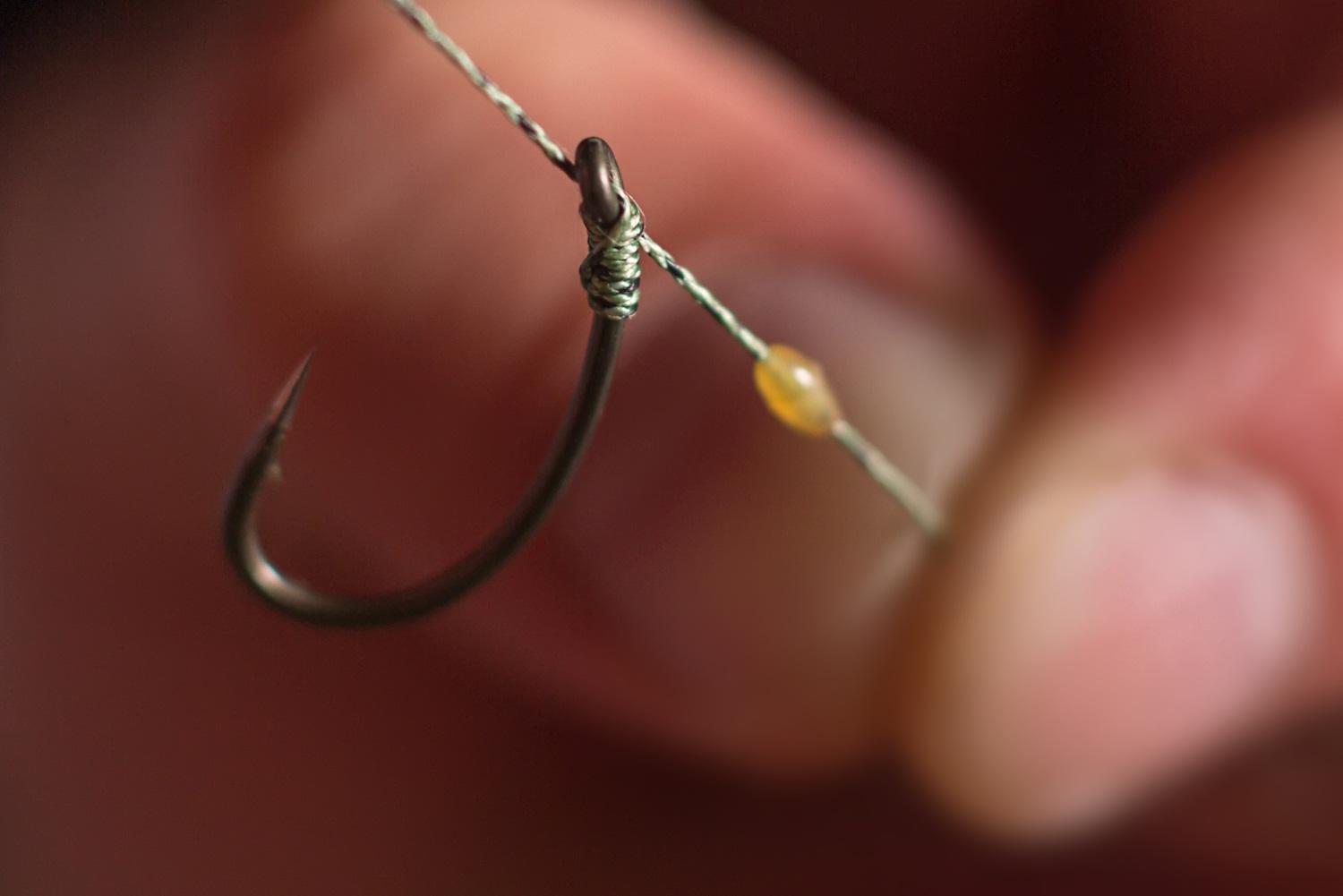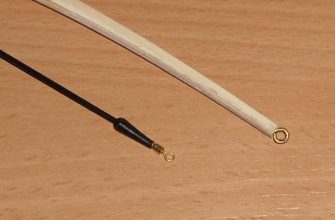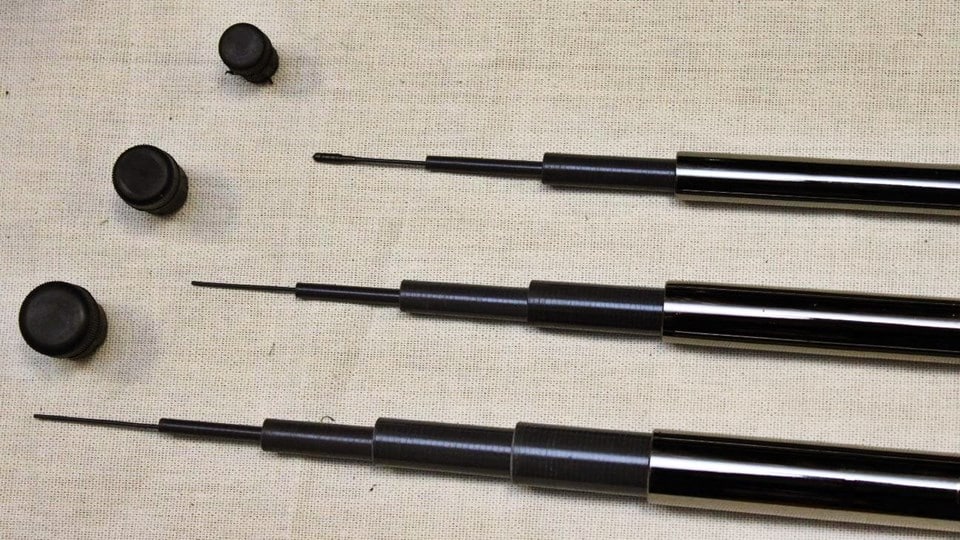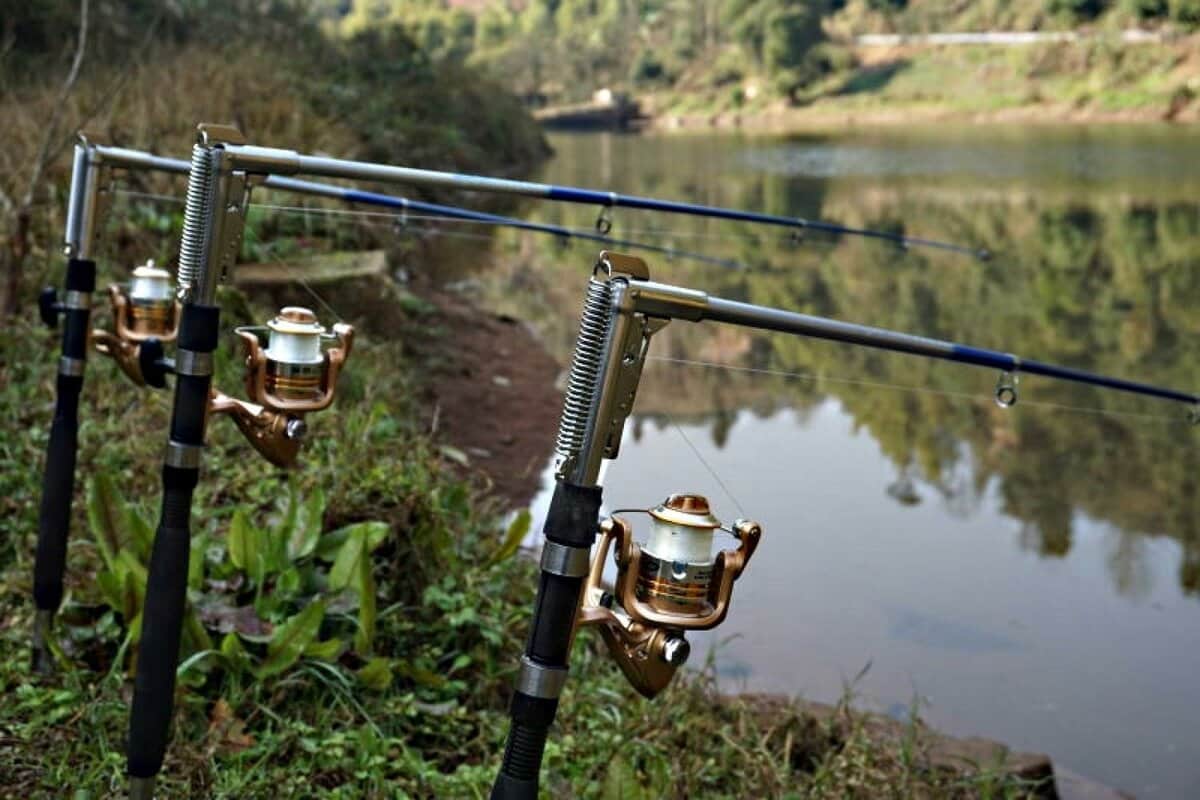Fishermen use fishing knots to tie hooks, lines and leashes all the time. In order for the connections to be reliable, you need to know what types of nodal connections are used in different cases. Next, we will talk about the most common types of nodes and the situations in which they should be used.
- Why is it important to choose the right fittings in fishing
- How to tie a hook to a fishing line – photo and video instructions
- Spatula hook
- Hook with eye
- How to tie a hook on a winter fishing rod
- How to attach a second hook to the main line on a winter fishing rod
- How to tie two hooks onto two leashes
- How to tie two hooks on a fishing rod to a fishing line correctly so as not to get confused
- Knots for thick and very thin lines
- How to tie a hook in fluorocarbon
- Spatula hook
- Hook with eye
- How to tie a fish hook to a line
- Spatula hook
- We knit a hook with an eye
- How to tie leashes to main line
- How to tie a leash to a spinning tackle
- Side leash
- Accessories for knitting fishing knots
- Strongest knots
- The simplest nodes
- Secrets and Tips
- Поделиться ссылкой:
Why is it important to choose the right fittings in fishing
When branded fishing products (lines, hooks, etc.) are sold, the recommended types of knots are often given in the instructions or on the packaging. This is due to the fact that you need to use exactly those that are suitable for a given case, for a specific tackle, for a specific line or cord. If the fisherman makes the wrong choice, it can lead to loosening or breaking of the line or leash, or to the fact that the rig loses its compactness. Some knots more than halve the bond strength.
How to tie a hook to a fishing line – photo and video instructions
To tie a hook, it is enough to use the proposed types of knots. Over the years, they have built a solid reputation among fishermen. Two easy ways to securely attach the hook to the line: Reliable: https://youtu.be/vCvOCt03R1M Simple: https://youtu.be/KKKN0nPf55Q
Spatula hook
The “stepped” knot is suitable for use with various types of fishing line. To tie a hook with a shoulder blade, take the following steps:
- The end of the line must be bent and positioned along the forend of the hook.
- From top to bottom, the tip is made several turns, grabbing one line and not touching the other. It is enough to make 2-3 turns.
- Then they make revolutions, moving down. But now they grab the fore-end and both lines. The tip is threaded into the lower loop.
- Then the knot must be tightened. This figure shows in detail the process of creating a node:
We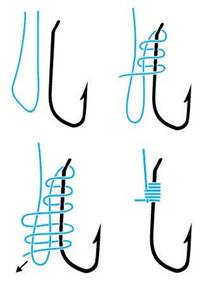
Hook with eye
For attaching, you can use the “Salmon” node. To do this, do the following:
- The tip is put into the eyelet, then two turns from bottom to top around the fishing line are made.
- The running end is led into the lower loop.
- The loop of the knot is lowered so that the hook is threaded through it from the bottom up.
- The knot is carefully lowered onto the shank of the hook. After that, it is carefully tightened.
Details can be found in this figure.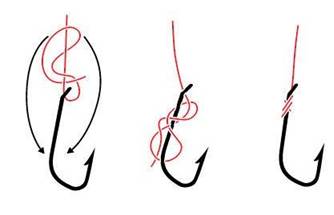
How to tie a hook on a winter fishing rod
For
winter fishing , moderate knot tightening is recommended. Too strong can lead to a cliff, and a weak one can untie. One of the most commonly used knots is the Canadian figure eight. It is knitted in this way:
- The leash is threaded into the eyelet.
- Then they circle the forearm.
- Thread between the fishing line and the hook.
- They are carried over the fishing line and threaded into the lower loop.
The node looks like this: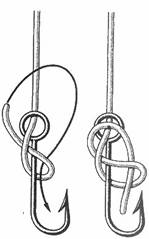
How to attach a second hook to the main line on a winter fishing rod
For winter fishing, it is convenient to use two hooks. If one is left without bait, then it will be possible to count on the second. To use two leashes. You can use this method:
- Take two leashes, put them together.
- Twisted on the finger three times.
- Thread through the loop and tighten.
Thus, a leash is obtained that has a fork in two. The lengths should be different so that the hooks do not get tangled. The leash can be attached to the main line in the usual way.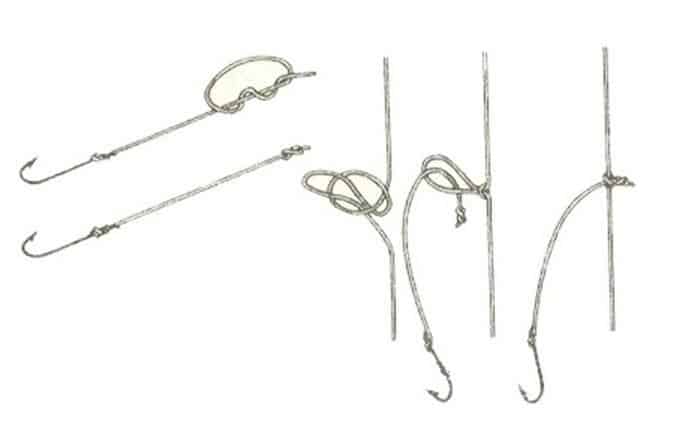
How to tie two hooks onto two leashes
To prevent the hooks from getting tangled, the leashes must be positioned so that the hooks are at a sufficient distance from each other. To attach the leash, you can make a temporary loop or use, for example, the Palomar knot.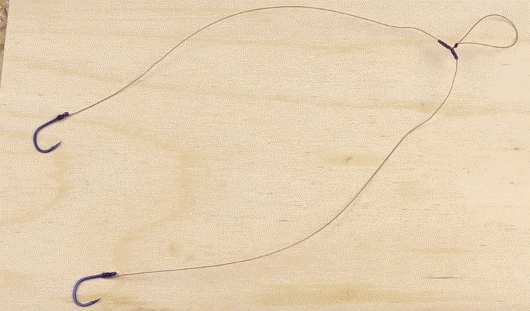
How to tie two hooks on a fishing rod to a fishing line correctly so as not to get confused
First you need to determine the distance between them. Then the tip is threaded through the eye of the hook, wrapped around the fore-end 5-6 times and once again threaded through the eye. The hook is now securely attached and cannot move. Another hook is attached to the tip of the fishing line.
Knots for thick and very thin lines
When
fishing with feeder , it becomes necessary to attach the shock leader to the main line. This knot will be strong even in cases where a very thin line is attached to the thick one. To link a node, you need to do the following:
- Two fishing lines are placed towards each other so that the ends lie parallel.
- The end of the left fishing line is circled around the right one and threaded into the resulting loop. It is slightly tightened.
- The end of the line on the right is wrapped back, creating a loop and laid on top of it. Then it is carried out under the fishing line from below, threading upwards through the resulting loop.
- Then an additional 3-4 times are wrapped around the fishing line, each time passing through the loop from bottom to top. Then the tip is pulled out of the loop parallel to the fishing line. In this case, it should be located parallel to the line and look back.
- The resulting loop is slightly tightened.
- Now both lines are pulled to the side so that the loops move towards each other.
The ends of the resulting knot are carefully cut off.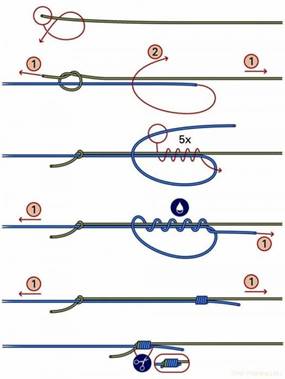
The resulting knot is also used by spinningists, it is called a carrot and is used to join the cord and fluor.
How to tie a hook in fluorocarbon
The following is about the knots you can use to tie the fluor to the hooks. They provide a secure hook connection.
Spatula hook
Using the “Bloody” knot will allow you to reliably attach the hook to the fluor with a thickness of up to 0.3-0.4. The knot is made using the following actions:
- The tip of the line is folded in half and placed parallel to the forend of the hook.
- Leaving a small loop, they wrap loosely around the forearm and fishing line several times, moving up.
- Then they are threaded from top to bottom inside all the loops made so that the tip comes out from below.
- The knot is moistened and tightened.
Details of creating a node can be clarified from the following figure: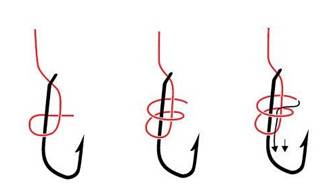
Hook with eye
You can use the Grinner knot for the eye hook. It is done this way:
- The line is threaded through the hole. The threaded tip is led back and parallel to the line.
- A loop is made about a third of the length of the tip. To do this, the remaining two-thirds are directed forward to the hook and held over the fishing line.
- Then the tip is threaded into the resulting loop from the bottom.
- Then 3-4 times they lead it up, cover the loop from the bottom and again thread it from the bottom up into the loop.
- The tip, which is threaded from the bottom up, is pulled back, tightening the knot. After that, they pull on the main part of the line, moving the knot close to the hook.
This knot is used not only for hooks, but also for attaching swivels. The following is a detailed diagram of how to tie a Grinner.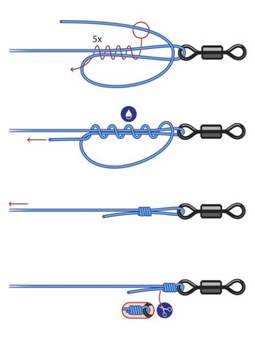
How to tie a fish hook to a line
The use of the knots listed below ensures a high-quality and reliable tying of the hook with a braid. Having learned to knit such knots, the fisherman can feel confident even when catching large fish.
Spatula hook
With such a simple knot, you can reliably tie the cord to a hook with a spatula:
- Fold the tip of the line in half and place it along the hook stem.
- Then they wrap the fishing line together with the forend, moving to the bend of the hook.
- Having reached the loop formed by the lower edge of the fishing line, the tip is threaded through it and then tighten the knot, having previously moistened the fishing line.
You can clarify the details in the following diagram.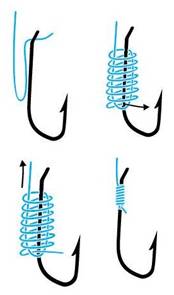
We knit a hook with an eye
For this purpose, the “Simple Clinch” can be used. We tie a knot with a braided cord on a hook as follows:
- The line is threaded through the eyelet and wrapped around the line five times.
- Then they are threaded into a loop formed by a braid next to the eye of the hook.
- The tip, threaded from the bottom up, is wound into a large loop and tightened.
You can also learn how to make this node correctly from this figure: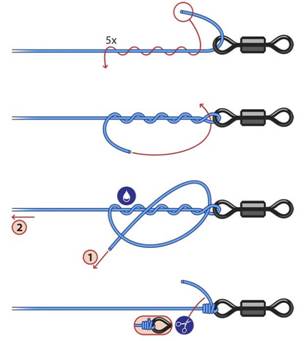
How to tie leashes to main line
To tie the leash to the main line, a triple fishing knot will do. To tie it, perform the following actions:
- The main line and leash are held together so that the ends point to the same direction.
- At a distance of 10-15 centimeters, a wide loop is made without tightening it.
- The ends are threaded several times through it in the same direction. This can be done two or more times.
- The knot is tightened by first pulling on both ends, then the line and leash in different directions.
The details of creating a knot can be clarified on this diagram: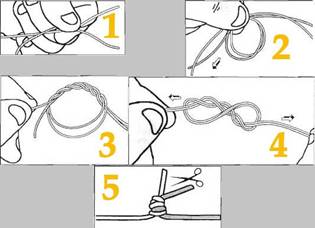
How to tie a leash to a spinning tackle
If you are using braid thicker than 0.10 mm or mono line thicker than 0.20 mm, then popular knots can be used to attach the leash without any restrictions. In the event that a thinner line is used, you need to choose the most reliable knots. For this purpose, for example, you can use the following node:
- The tip of the leash is passed through the hole two times.
- Wrap five times along the leash.
- The tip is passed a loop, which was formed when passing twice through the hole. Then it is threaded into a large loop on a leash.
- Then the knot is moistened and tightened.
It is used to attach to a swivel or loop. The diagram shows in detail the operations that must be performed: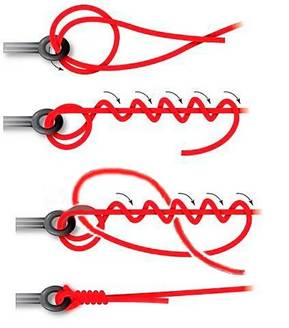
Side leash
To create a side leash, you can make a loop in the right place. It is knitted in this way:
- The line is wrapped twice around the finger, then the loops are collected.
- Nearby, a small section of the fishing line is folded in half and threaded into the created loop.
- The double tip is pulled, but not hard. A leash is threaded into the resulting loop, then pulled by the main line in different directions. As a result, the line will tightly cover the leash. At its end, so that it does not slip out, a knot is first made.
This loop is secure, but temporary. If you take out the leash and pull the line in different directions, it will disappear. The details of the procedure can be clarified from the following figure: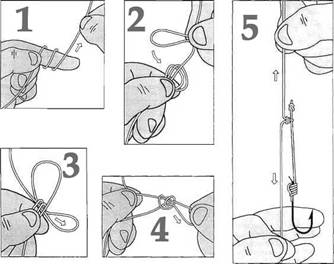
Accessories for knitting fishing knots
Knots can be easily tied by hand. Many do just that. However, it is much more convenient to use devices specially designed for this. Most often, a special knot tightener is used, which looks like this.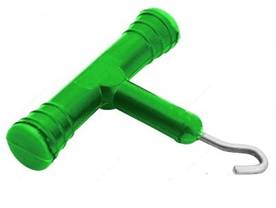
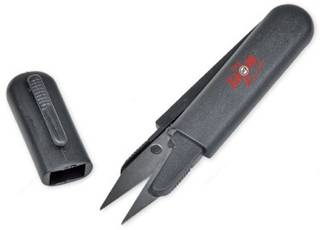
Strongest knots
The Snell knot is considered one of the most reliable. How to do it correctly will be explained using the example of attaching a hook:
- Thread the fishing line through the eyelet, make a loop and thread the tip a second time into the hole.
- The resulting loop is turned over and the hook is threaded through it from the bottom up.
- Then turn it over again in the same direction and thread the hook again from the bottom up.
- Repeat this action 5-6 more times, then tighten the knot.
This knot is highly durable. The load is evenly distributed over the entire tooling. Can be used for braiding or monofilament. https://youtu.be/i_s0rBz-8wI
The simplest nodes
Palomar is considered one of the simplest and most reliable units. The following will tell you how to attach a swivel or hook with it. To tie, you need to take the following steps:
- The tip of the line is folded in half. They are threaded through the hole.
- The fold of the line is led back and placed over the double part, crossing with it.
- The double tip is passed from below under the fishing line and brought up through the loop.
- The doubled part is expanded and the swivel is threaded from bottom to top through it.
- The knot is carefully tightened, and the protruding tip is cut off, leaving a few millimeters.
To better understand how to knit “Palomar”, you should look at this picture: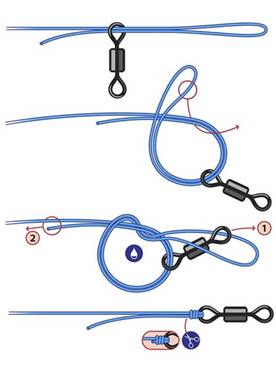
Secrets and Tips
When tying fishing hooks, pay attention to the following:
- It is recommended to wet the knot when tightening . This can be done, for example, with saliva. This will make it better to tighten the knot due to the reduced friction force. Wetting can prevent line damage due to abrasion or overheating.
- When making a knot on a monofilament, you need to hold it in the sun for a bit . This will soften the material and allow you to tie a more secure knot.
- When choosing a suitable option, it is recommended to prefer a simpler connection . The fewer bends, the higher the strength will be.
- When a long tip remains after tying, it is not recommended to burn it with an open flame. It is better to cut it off with scissors, leaving 2-3 mm .
The simpler the knot, the stronger and more reliable the connection will be.
